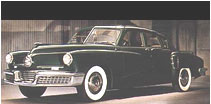Some celebrated cars are born of vision; others are created by necessity. Of these, the 1949 Ford belongs in that second class.  As a major component of “The Arsenal of Democracy,” Ford Motor Company was a gigantic contributor to the war effort, building not just trucks and Jeep and other vehicles but also airplane components. However, like some veterans, Ford survived and thrived in the war only to have its very existence threatened by the peace.
As a major component of “The Arsenal of Democracy,” Ford Motor Company was a gigantic contributor to the war effort, building not just trucks and Jeep and other vehicles but also airplane components. However, like some veterans, Ford survived and thrived in the war only to have its very existence threatened by the peace.
Innovation is good, even better
When World War II came to a close in 1945, four years of war had created four years of pent-up consumer need for automobiles, so the immediate post-war market swallowed up just about any new vehicle that could be manufactured. But Henry Ford II, who sat atop the Ford Motor Company, was savvy enough to recognize that when the initial boom died down, the consumer would seek out modern comfort and convenience, and that was something Ford Motor Company, in the immediate post-war days, was simply not ready to provide. Read more . . .
 The concept of a extremely styled, civilized pickup truck was definitely not new when the El Camino was introduced to the public in the 1959 model year, and it turned out that the ’59 Camino was more an artistic triumph than a commercial triumph, but that does not diminish the importance of the vehicle. After getting its second chance, it produced a line that would extend for 25 years.
The concept of a extremely styled, civilized pickup truck was definitely not new when the El Camino was introduced to the public in the 1959 model year, and it turned out that the ’59 Camino was more an artistic triumph than a commercial triumph, but that does not diminish the importance of the vehicle. After getting its second chance, it produced a line that would extend for 25 years. In others words, nice attempt; call us again when you have a winner.
In others words, nice attempt; call us again when you have a winner. Five decades after he introduced his great car upon an unsuspecting public, those questions are impossible to answer. But the fact is, he was possibly all of these things and more, for the story of Tucker and his Torpedo is the story of America in the wonderful, dreadful aftermath of World War II. It’s the story of hoping against hope and daring to be different and,finally, the story of failure either unfairly thrust upon him or richly deserved.
Five decades after he introduced his great car upon an unsuspecting public, those questions are impossible to answer. But the fact is, he was possibly all of these things and more, for the story of Tucker and his Torpedo is the story of America in the wonderful, dreadful aftermath of World War II. It’s the story of hoping against hope and daring to be different and,finally, the story of failure either unfairly thrust upon him or richly deserved.